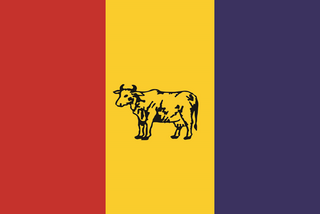
The politics of Nepal functions within the framework of a parliamentary republic with a multi-party system. Executive power is exercised by the Prime Minister and their cabinet, while legislative power is vested in the Parliament.

The Nepali Congress is the oldest democratic socialist political party in Nepal and the largest party in the country. The party has 870,106 members as of the party's 14th general convention in December 2021 making them the largest party by membership in Nepal. Currently the party has started online membership since the emergence of youth leaders in vital post to bring youths into the party.

Jamaat Ansar al-Sunnah, also known as Jaish Ansar al-Sunna, Ali ibn Abi Talib Battalion or simply as Ansar al-Sunnah was an Iraqi Sunni insurgent group that fought against US troops and their local allies during the Iraq War. The group was primarily based in northern and central Iraq, and included mostly Iraqi fighters. In 2007, it split; with its Kurdish members pledging allegiance to Ansar al-Islam, and its Arab members creating a group called Ansar al-Sunnah Shariah Committee, before changing its name to Ansar al-Ahlu Sunnah in 2011.
Events from the year 2004 in Nepal.

Sher Bahadur Deuba is a Nepali politician and former prime minister of Nepal and the current leader of the Opposition. He has also been serving as the president of the Nepali Congress since 2016. Deuba has served five terms as prime minister and is the Member of Parliament for the parliamentary constituency of Dadeldhura 1.

The Rastriya Prajatantra Party (Nepali pronunciation:[rasʈrijʌprʌˈd͡zatʌntrʌˈpa ʈi]; Nepali: राष्ट्रिय प्रजातन्त्र पार्टी, lit. 'National Democratic Party'; abbr.RPP, RaPraPa is a constitutional monarchist and Hindu nationalist political party in Nepal.

Kantipur Publications Pvt. Ltd. is a media firm based in Kathmandu, Nepal. The company operates five widely circulated print publications. It is the first media organization in Nepal to gain membership to the World Association of Newspapers and News Publishers (WAN). It was founded by Shyam Goenka in 1993. Mr. Kailash Sirohiya is the chairman of the company.

Rastriya Janashakti Party was a liberal political party in Nepal, led by former Prime Minister Surya Bahadur Thapa. Thapa had split away from the Rastriya Prajatantra Party in November 2004. The party was registered with the Election Commission of Nepal in March 2005. The party merged into Rastriya Prajatantra Party on July 25, 2007.
Rastriya Prajatantra Party, Nepal is a Hindu right-wing, cultural conservative party. It previously existed as royalist political party in Nepal from 2006 to 2016. The party was formed as a splinter of Rastriya Prajatantra Party in 2006 and was later reunified in 2016. The party was reformed in 2022 by Kamal Thapa.
Renu Kumari Yadav is a Nepali politician and member of House of Representatives on proportional representation.

Prakash Man Singh is a Nepalese politician and a leader of the Nepali Congress. He is the son of Nepali politician Ganesh Man Singh. He has also served as the Deputy Prime Minister and Minister of Local Development and Federalism in Sushil Koirala's Cabinet.

Gagan Kumar Thapa is a Nepali politician and youth leader, who is the current General Secretary of the Nepali Congress. He is currently serving as a Member of Parliament in the House of Representatives, Nepal from Kathmandu since 2008, and is currently in its Parliamentary Committee on Education and Health. He served as the Minister of Health and Population of Nepal from 2016 to 2017.
Events from the year 2005 in Nepal.

Bidya Devi Bhandari is a Nepali former politician who served as the second president of Nepal from 2015 to 2023. She formerly served as the minister of defence and minister of environment and population.

General elections were held in Nepal in two phases on 26 November and 7 December 2017 to elect the 275 members of the fifth House of Representatives, the lower house of the Federal Parliament of Nepal.

On 7 June 2017, Sher Bahadur Deuba got elected as the new Prime Minister of Nepal and therefore formed the new Governmental Cabinet of Nepal Deuba's candidacy was supported by the Rastriya Prajatantra Party Nepal, the Rastriya Janata Party Nepal, the Nepal Loktantrik Forum, the Federal Socialist Forum, Nepal and several small parties represented in the Nepalese Parliament after a power-sharing deal with the Communist Party of Nepal, who also supported Deuba's candidacy. After being sworn in, Deuba formed a new government in a coalition with the parties that supported his election. On 17 October 2017, in preparation for the Nepalese legislative election, the Communist Party of Nepal decided to cooperate with the Communist Party of Nepal. For this, all of their ministers left the cabinet after Prime Minister Deuba was prepared to dismiss them.

Durga Baral, professionally known as Batsyayana is a prominent Nepali political cartoonist and painter.
The 2004 Nepal riots were a series of riots between 31 August to 6 September 2004. Thousands of people rioted in cities and towns across Nepal, which saw looting, arson, as well as imposed curfew and the deaths of two people.











